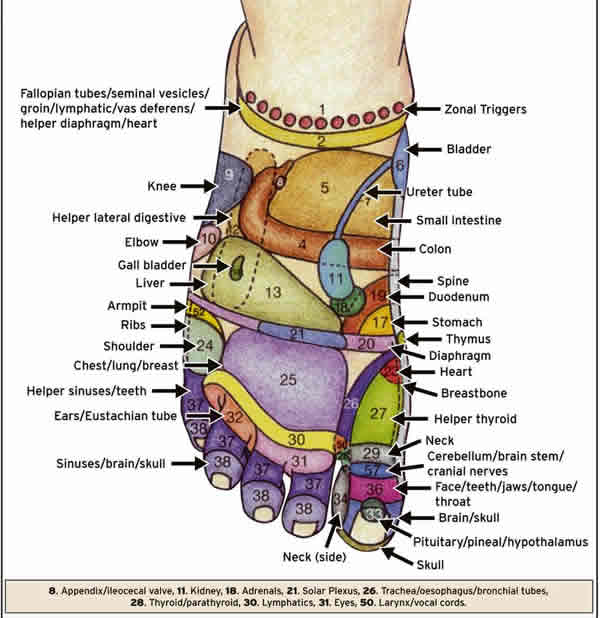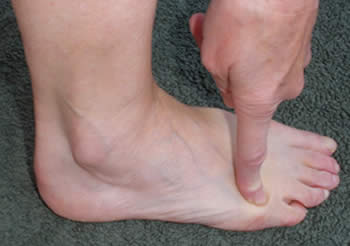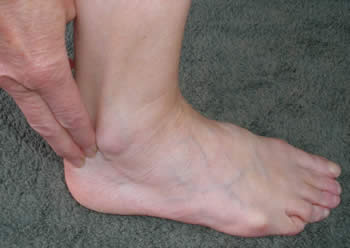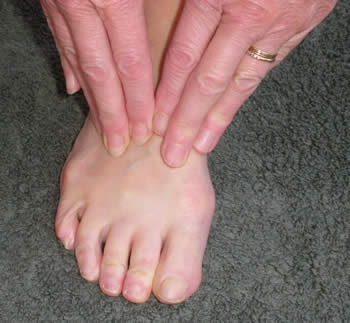Positive Health Online
Your Country

Reflexology and Shoulder Issues
listed in reflexology, originally published in issue 187 - October 2011
Shoulder problems are some of the most common conditions that people present to complementary practitioners and medical doctors. In my own practice, as a Reflexologist, I am constantly aware of how many people complain of muscular tightness around their shoulders which can, in turn, lead to other issues such as headaches, stiff or painful arms, nerve tingling in the fingers and referred neck and back pain. Many clients seek a Reflexologist to address other health issues but, as the reflexology treatment progresses, the sensitive shoulder reflexes (primarily located below the little toe) signify possible stress and tension in the muscles and ligaments that surround the head, shoulders and neck. Many clients take it for granted that they live with stress and respond well to the suggestion that reflexology may help release tension in their shoulders and neck. As reflexology is an holistic therapy, the whole body is always treated and stimulated in every session so the therapist is able to address a wide range of issues to help create a general sense of homeostasis (balance).

Reflexology is a gentle and effective therapy in which the Reflexologist's hands are used to apply subtle pressure to reflex points on the feet. It is ancient science, dating back 5000 years, that states that all the glands, organs and parts of the body have a corresponding reflex point on the feet (and hands). In my work with older people, I find that many suffer with joint pain and possible arthritic conditions. Many are on anti-inflammatory medication and often experience an increase in pain prior to their next designated dose of pain-killers. I like to offer my clients "homework", to support them in between appointments, and give them short, simple self-help techniques to try to help trigger the body to help itself. (see instructions at end of article). Musculo-skeletal issues appear to respond well to reflexology and an observational study conducted in Beijing, China looked at 39 cases of shoulder pain in a sample group ranging in age from 49 to 58 years old. At the completion of the reflexology treatments, 32 people reported that the pain appeared to have disappeared and their arms and shoulders could move freely and the others reported a measurable positive effect ie pain reduction plus an obvious improvement in the movement of the arm and shoulder. Ref 1
There are three main bones that make up the shoulder joint include the clavicle (collarbone), scapula (shoulder blade), and humerus (long bone of the arm). The shoulder joint is a 'ball and socket joint'. The 'ball' is the top, rounded part of the humerus, and the 'socket' is the bowl-shaped part of the scapula, called the glenoid, into which the ball fits. This joint allows the arm to move in a circular rotation as well as towards and away from the body. Ball and socket restriction can prevent a person performing normally simple tasks. Many years ago I was asked to see a 76 year old woman who had very bad hip pain and I worked the dorsum (top) of her feet using Vertical Reflex Therapy (VRT) Ref 2 and 3 on her semi-weight bearing feet as she sat in her wheel chair. I simultaneously worked her hip and shoulder reflexes as they are aligned in the same 'energetic zone' on reflexology charts and the shoulder and hip are similarly aligned on the body.
Her hip issues only improved a little in terms of mobility and this aspect of the treatment was not considered to be a success, but after the reflexology she reported much less stiffness in her shoulders and she found she was able to lift her arm much higher. She proudly showed me how she could now brush the back of her hair again for the first time in months. This small improvement went far beyond the benefit of a decrease in pain; it also empowered her to take control of a small but important action, namely being able to brush her hair herself and take a pride in her appearance once more. It is also important to give clients self-help reflexology between appointments so this client would gently rub the area below her little finger (shoulder reflex ) on her hands and on lateral edge of her wrists (hip reflex). She was advised to find the designated tender or sensitive reflex that related to her shoulder/hip issues and she would work this when she was in pain or knew that she had a while to wait before her next pain killer. She reported that, following her self-help, the intense pain would often ease or turn in to a more bearable dull ache. In some other cases clients, who work specific reflexes for shoulder pain, have reported that they have not felt the need to take off-the-counter allopathic medication so frequently.
Client: Male 56 years, politician
Condition: Inflammation of right shoulder.
Duration: 4 weeks.
The client has suffered pain for 4 weeks and presented with a very tender shoulder which he could hardly move. It took a while before he could take off his jacket , with help, and was seated in a chair. He was exhausted through lack of lack of sleep. His shoulder pain began at the end of a very stressful period when he was working more than 12 hours a day. He left for a holiday but was in so much pain a doctor prescribed anti-inflammatory medication and , when the drugs did not seem to help him much, he took to drinking several glasses of Spanish wine to gain extra sleep. He had his first reflexology treatment on his return and his neck reflexes reflected tension and sensitivity as his entire shoulder area was painful.
Classical reclining reflexology was given and the weight-bearing VRT techniques were applied to the adrenal and diaphragm reflexes to try and help him relax and relieve his pain. He reported that he felt the reflexology was working and came twice a week - becoming more energetic again and was elated to show the progress every time. From the second treatment VRT was applied to the following foot reflexes :his whole spine (lower lumbar reflexes were tender to touch), cervical neck area, brachial tunnel (nerve to shoulder joint), shoulder area, axillary nerve, diaphragm and adrenals. Within 6 visits he could perform nearly every movement with his right arm without pain. He then continued to receive reflexology once a month for maintenance and relaxation..
Hedwige Dirkx, Reflexologist, Tutor and VRT Practitioner , Belgium
VRT/ Reflexology Shoulder Exercise
Self-help: takes 3 - 4 minutes
1. Place your foot on a firm upright chair and lean forward a fraction to ensure your leg is weight-bearing;
2. Whole Body. Using both hands on one foot work swiftly round the ankle pinching and pressing firmly (but not painfully) with your fingers and thumbs. These techniques may help to stimulate the whole body to respond to VRT/reflexology. Repeat on other foot;
3. To specifically work the shoulder: Find a tender reflex on the foot 2 cms below the little toe. When located rotate your finger on that point for a few seconds.
4. To Stimulate the Hip Relexes. Press your fingers and thumbs three times up and down the inside bony edge of your feet on the spinal reflexes . Work round the base of the big toe for the neck. Work the lateral (outside) reflexes on the heel to stimulate the hip reflexes. 
6. Whole Body Including Tense Neck and Shoulders. With two hands on one foot, work your fingers down from the ankle to the toes pressing in tiny little 'bites' to stimulate the whole body including the tense neck and shoulders. Let your fingers glide off the toes.
7. Repeat on the other foot..
References
1. Yu Baofu, Han Houngling, Yang Huaiqing, Li Caixia, Treatment of Shoulder-Joint Pain with Foot Reflexology. Beijing International Reflexology Conference Report, China Reflexology Association, Beijing, pp. 69-70. 1998
2 Booth, Lynne. Vertical Reflexology for Hands. Publ Piatkus Books, London. ISBN: 0-7499-2319-9 2003.
3. Booth, Lynne. Vertical Reflexology. Publ Piatkus Books, London. ISBN: 0-7499-2132-3. 2008.
Comments:
-
Elizabeth McMaster said..
Love your article and the self care tips!!
-
Ionatana Sopi Lavea said..
Thank you, thank you very much, your reflexology treatment is great helps me